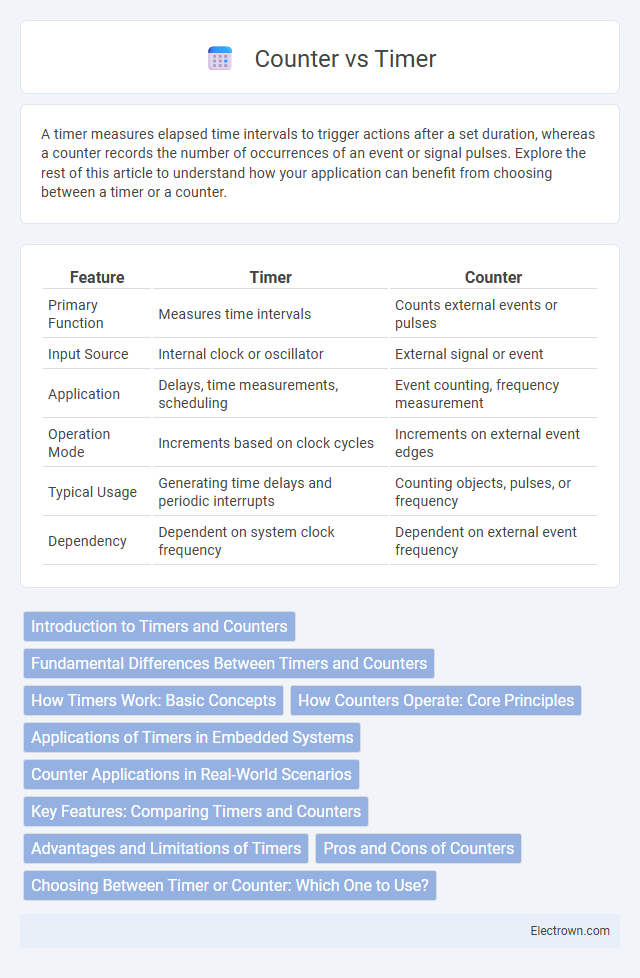A timer measures elapsed time intervals to trigger actions after a set duration, whereas a counter records the number of occurrences of an event or signal pulses. Explore the rest of this article to understand how your application can benefit from choosing between a timer or a counter.
Table of Comparison
| Feature | Timer | Counter |
|---|---|---|
| Primary Function | Measures time intervals | Counts external events or pulses |
| Input Source | Internal clock or oscillator | External signal or event |
| Application | Delays, time measurements, scheduling | Event counting, frequency measurement |
| Operation Mode | Increments based on clock cycles | Increments on external event edges |
| Typical Usage | Generating time delays and periodic interrupts | Counting objects, pulses, or frequency |
| Dependency | Dependent on system clock frequency | Dependent on external event frequency |
Introduction to Timers and Counters
Timers measure elapsed time intervals by counting clock pulses, while counters track the number of external events or pulses. Both timers and counters are essential components in microcontrollers and digital systems, enabling precise time management and event counting for various applications. Understanding your device's timer and counter capabilities ensures accurate control of timing operations and event tracking.
Fundamental Differences Between Timers and Counters
Timers measure time intervals by counting clock pulses over a specified period, enabling precise control of time-based events in microcontrollers. Counters track the number of external events or pulses, incrementing their value with each detected input signal to monitor occurrences or trigger actions after a set count. The fundamental difference lies in timers operating internally based on clock frequency, while counters rely on external signals for their increment, making their applications distinct in embedded systems.
How Timers Work: Basic Concepts
Timers function by measuring time intervals based on the oscillations of a clock signal, incrementing their count value at each pulse. They operate using internal clock sources, allowing precise tracking of elapsed time for operations such as generating delays or triggering events. Configurable settings like prescalers adjust the counting speed, enabling versatile timing control in embedded systems.
How Counters Operate: Core Principles
Counters operate by incrementing or decrementing a value based on input pulses, effectively tracking the number of occurrences of an event. They use a clock signal or external triggers to update their state, storing the count in binary or decimal format for precise measurement. Your control system relies on these core principles to count events, manage sequences, or generate timing intervals accurately.
Applications of Timers in Embedded Systems
Timers in embedded systems are essential for measuring time intervals, generating precise delays, and scheduling tasks such as sensor data acquisition or communication protocols. They enable your microcontroller to perform time-based operations like pulse width modulation (PWM), watch-dog functions, and real-time clock implementation. These applications enhance system reliability and efficiency by ensuring accurate timing control and synchronization.
Counter Applications in Real-World Scenarios
Counters are essential in real-world applications such as event counting, frequency measurement, and digital clocks where precise tallying of occurrences is required. In industrial automation, counters track production line items or machine cycles to ensure accurate monitoring and control. Your systems can benefit from these counters to improve operational efficiency and data accuracy.
Key Features: Comparing Timers and Counters
Timers measure elapsed time intervals based on a fixed clock frequency, providing precise time delays and scheduling in microcontrollers. Counters increment or decrement in response to external events or pulses, enabling event counting or frequency measurement with high accuracy. Both utilize internal registers and clock sources but differ in application: timers focus on timing control while counters specialize in event quantification.
Advantages and Limitations of Timers
Timers offer precise time measurement and scheduling capabilities essential for applications requiring accurate time delays or periodic events, such as in embedded systems and real-time operating systems. Their advantages include low power consumption, easy integration with microcontrollers, and the ability to generate interrupts for efficient processor management. However, timers are limited by their resolution and maximum count value, which restricts their use in high-frequency timing or very long duration measuring without additional hardware or software compensation.
Pros and Cons of Counters
Counters provide precise event counting, making them ideal for applications requiring accurate measurement of occurrences, such as frequency calculation or digital event tracking. Their hardware simplicity and high reliability allow efficient operation with minimal power consumption, but they tend to have limited versatility compared to timers, often being restricted to increment or decrement functions without complex timing capabilities. Manufacturers must consider counter resolution and overflow risks when integrating counters into systems, as these factors may limit their effectiveness in long-duration or high-frequency scenarios.
Choosing Between Timer or Counter: Which One to Use?
Choosing between a timer or counter depends on whether you need to measure elapsed time or count specific events. Timers are ideal for tracking durations and generating time delays, while counters excel at tallying occurrences such as pulses or external signals. Assessing your project's need for precise time intervals versus event counting helps determine if your application requires a timer or counter.
Timer vs Counter Infographic

 electrown.com
electrown.com